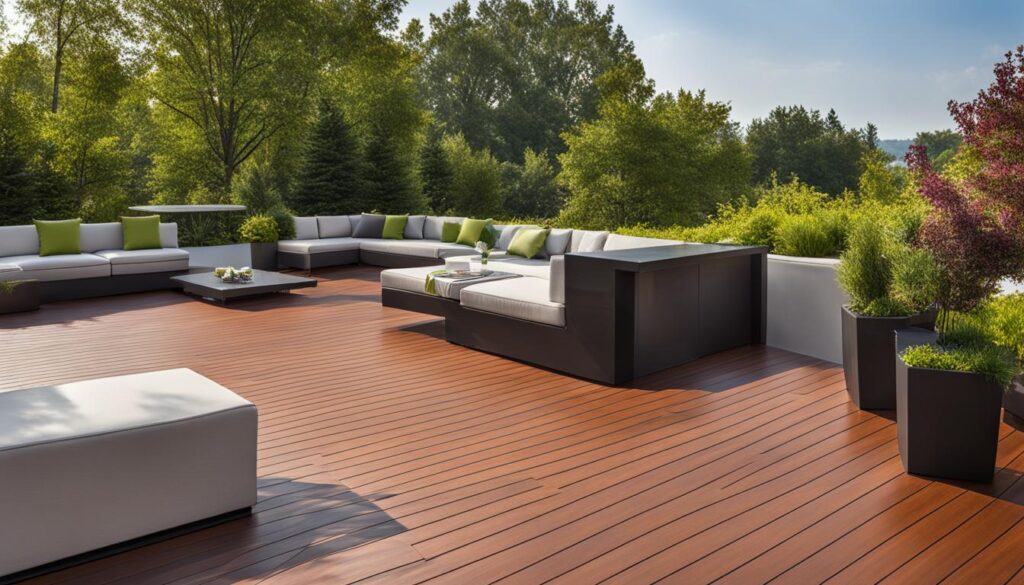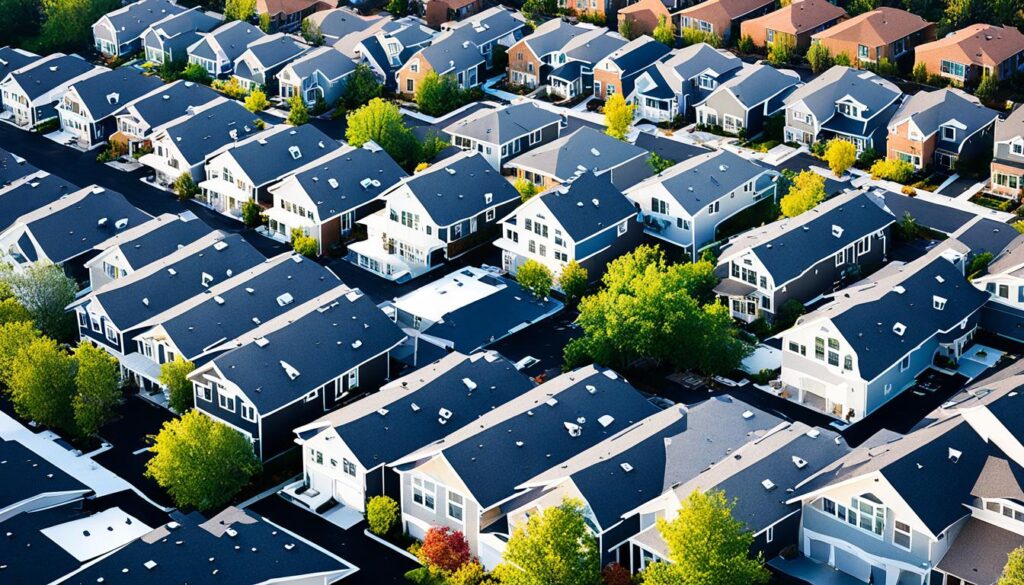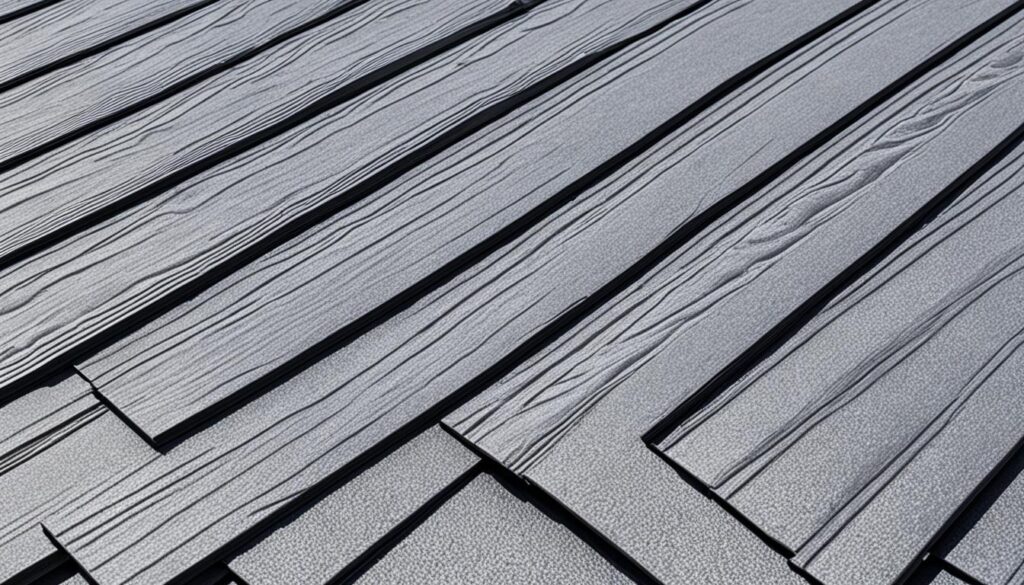When it comes to roofing your home, there are many factors to consider – from the type of roofing materials to the installation process. But have you ever thought about the importance of roof decking in the equation? The structural foundation of your roof plays a crucial role in its performance and longevity. So, what exactly is roof decking, and why is it essential?
Roof decking refers to the layer of material that is installed between the structural components, insulation, and weatherproofing material of your roof. It provides the necessary support for the outer layers of the roof and helps maintain the roof’s structural integrity. Roof decking comes in different types, each with its own advantages and considerations.
In this article, we will explore the various types of roof decking, the benefits of vinyl decking, different waterproofing options, the importance of proper installation techniques, and more. By the end, you’ll have a better understanding of the significance of quality roof decking solutions for your home.
Key Takeaways:
- Roof decking is an essential component of a roofing system, providing the necessary structural foundation.
- There are different types of roof decking, including solid sheathing, open sheathing, plank decking, and sheet decking.
- Vinyl decking offers unique benefits, such as waterproofing, durability, and a walkable surface.
- Not all waterproofing options are suitable for roof decks, making waterproof vinyl decking an attractive solution.
- Proper installation techniques and attention to detail are crucial for the longevity and performance of roof decking.
Benefits of Vinyl Roof Decking
Vinyl decking, also known as PVC membrane roofing, offers unique benefits for flat roof decks. It not only acts as a waterproof barrier but also provides a durable and walkable surface. Unlike other roofing materials, vinyl decking is designed to handle continuous exposure to water, heat, wind, and foot traffic. It is a multi-ply membrane that ensures complete waterproofing and can be a suitable option for outdoor living spaces.
Vinyl decking is available in various colors and patterns, allowing homeowners to create an aesthetically pleasing outdoor space. With proper installation, vinyl decking can last for 10-20 years or more, making it a long-lasting and low-maintenance choice for roof decking.
With its waterproof properties, vinyl decking provides reliable protection against water damage. It eliminates the need for additional waterproofing layers and simplifies the deck installation process. Vinyl decking creates a seamless and non-porous surface, preventing water from seeping into the underlying structure and causing damage.
Furthermore, vinyl decking offers excellent durability. It can withstand harsh weather conditions, including extreme temperatures and UV exposure, without deteriorating or losing its integrity. This durability ensures that the roof deck remains structurally sound and maintains its aesthetic appeal over time.
In addition to its waterproof and durability benefits, vinyl decking is also highly walkable. Its surface is slip-resistant, providing safe footing for both residents and guests. Vinyl decking is comfortable to walk on, even in bare feet, and does not retain heat like some other materials, making it ideal for enjoying outdoor spaces during hot weather.
Overall, the benefits of vinyl decking make it an attractive option for homeowners looking to enhance the functionality and aesthetics of their roof decks. Its waterproof properties, durability, and walkable surface provide a reliable and long-lasting solution for creating outdoor living spaces that can be enjoyed for years to come.
Different Types of Waterproof Roof Decking
When it comes to waterproofing roof decks, it’s essential to choose the right materials that provide a true waterproof seal and are suitable for outdoor living spaces. While there are several options available, not all of them deliver the desired results. Let’s explore some of the different types of waterproof roof decking and their pros and cons.
Asphaltic Tar
Asphaltic tar is a traditional option for waterproofing roof decks. It is known for its durability and resistance to UV rays. However, asphaltic tar can be heavy and smelly during installation, and it may require additional finishing products to achieve the desired waterproofing. Additionally, it can be challenging to maintain and has a shorter lifespan compared to other options.
Torch On
Torch-on systems consist of modified bitumen sheets that are heat-applied to create a waterproof barrier. While torch-on materials offer excellent waterproofing properties, they can also be heavy and have a strong odor during installation. Additionally, these systems may require a separate protective layer to ensure durability.
Built-Up Roof (BUR)
Built-up roof systems involve multiple layers of asphalt and felt or fiberglass mat, creating a durable and waterproof surface. However, BUR systems can be uncomfortable to walk on due to the gravel layer used for protection. They also add significant weight to the roof structure, requiring careful consideration and reinforcement.
Spray-On Coating
Spray-on coatings, such as elastomeric or acrylic formulas, offer seamless and waterproof protection for roof decks. While these coatings are primarily used in commercial applications, they may not be aesthetically pleasing for residential outdoor living spaces. Additionally, they require professional installation and may require regular maintenance for long-term performance.
Waterproof Vinyl Decking

For homeowners seeking a reliable and attractive solution for their roof decks, waterproof vinyl decking is an excellent option. Brands like Tufdek™ offer a fully waterproof surface that is also slip-resistant and easy to maintain. Vinyl decking provides the durability and longevity required for outdoor applications and comes in a variety of colors and patterns to enhance the overall appearance of the space.
Waterproof vinyl decking, such as Tufdek™, offers a reliable and attractive solution for roof decks. It provides a fully waterproof surface that is also walkable and can enhance the overall appearance of the outdoor living space.
Choosing the right waterproofing option for your roof deck depends on various factors, such as durability, maintenance requirements, and aesthetic preferences. It’s important to consider the specific needs of your project and consult with roofing professionals to determine the best solution for your home.
The Importance of Waterproof Decking Details
Proper waterproofing techniques and attention to detail during the installation process are crucial for the longevity and performance of roof decking. Professional installers with experience in waterproof detailing can ensure a tight and durable seal. When using a vinyl surface, such as Tufdek™, the waterproofing extends beyond just the surface, with integration into the structure of the building. This comprehensive approach minimizes the risk of future water damage. Additionally, choosing a vinyl decking product that offers a strong warranty provides peace of mind and ensures the product’s quality and performance. Taking these factors into consideration and working with certified contractors can result in an optimal and long-lasting waterproof roof deck.
Proper Waterproofing Techniques
Effective waterproofing techniques are essential to protect the roof and the underlying structure from water infiltration. When it comes to vinyl decking, professional installers should follow the manufacturer’s guidelines to ensure proper installation. This includes properly preparing the substrate, applying the vinyl membrane, and sealing all edges. The use of high-quality adhesives, waterproof sealing tapes, and specialized tools guarantees a secure and watertight installation.
Integration into the Building Structure
Unlike other decking materials, vinyl surfaces like Tufdek™ provide more than just a waterproof layer on top. These systems integrate into the building structure, preventing water from penetrating the roof deck and causing damage or leaks. By extending the vinyl surface up vertical surfaces, such as parapet walls or upturns, and properly sealing all penetrations, the risk of water intrusion is significantly reduced.
Warranty for Peace of Mind
Choosing a vinyl decking product that comes with a strong warranty is vital to ensure the quality and performance of the roof deck. A comprehensive warranty not only covers the vinyl surface but also provides protection against manufacturing defects or failures. This warranty serves as a guarantee of the product’s durability and can provide homeowners with peace of mind knowing that their investment is protected.
By considering proper waterproofing techniques, integrating the vinyl surface into the building structure, and selecting a product with a strong warranty, homeowners can enjoy an optimal and long-lasting waterproof roof deck. Working with certified contractors who specialize in vinyl decking installation further ensures the quality and success of the project. Remember, attention to detail during the installation process is key to a waterproof deck.
| Benefits | Waterproofing Techniques | Integration | Warranty |
|---|---|---|---|
| Ensures longevity and performance | Follow manufacturer’s guidelines | Vinyl surface integrates with building structure | Protection against defects and failures |
| Minimizes the risk of water damage | Proper preparation and sealing | Seals vertical surfaces and penetrations | Guarantee of product durability |

Conclusion
Roof decking is an integral component of a roofing system that provides structural support, contributes to waterproofing, and enhances the aesthetics of outdoor living spaces. Choosing the right type of roof sheathing material, such as solid sheathing or sheet decking made of plywood or OSB, is crucial for ensuring durability and resistance to moisture.
Alternatively, vinyl decking offers a range of unique benefits for roof decks. Its waterproofing capabilities, durability, and walkability make it an attractive option for homeowners. With proper installation techniques and attention to detail, a tight seal can be achieved, minimizing the risk of water damage and ensuring long-term performance.
By considering factors such as roof decking materials, durability, maintenance, and aesthetics, homeowners can create a durable and visually appealing roof deck that adds value and functionality to their homes. Whether opting for traditional roof sheathing or vinyl decking, choosing a high-quality product and following proper installation practices are essential for achieving optimum results and enjoying a beautiful, low-maintenance roof deck.

Meet William Adams, a seasoned roofing expert with over 30 years of hands-on experience in the industry. Having worked tirelessly under the scorching sun and through the fiercest storms, William brings a wealth of knowledge and expertise to the table. Hailing from the heart of the USA, he’s witnessed the evolution of roofing practices firsthand, mastering every aspect along the way. Now retired from the field, William spends his days cherishing time with his loved ones while sharing his invaluable insights through this platform. With William at the helm, you can trust that every tip, advice, and recommendation provided is backed by years of real-world experience and unwavering dedication to quality craftsmanship. Join us as we journey through the world of roofing, guided by the wisdom and passion of a true industry veteran.

